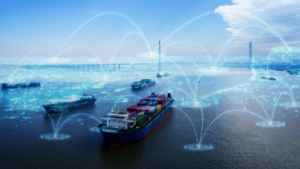Maritime Communication: The Top 3 Reasons Reliable Communication is a Must.

 Effective communication is vital in any industry, but for those working in the maritime sector, it’s not just a convenience—it’s a matter of safety and operational efficiency. With the unpredictable and harsh nature of maritime environments, communication breakdowns can lead to costly delays, safety risks, and compromised crew well-being. In an industry where conditions can change in an instant, it’s important that technology is as tough as the environment it’s used in. Whether navigating through rough seas, managing operations on a busy deck, or responding to emergencies, having dependable communication tools is non-negotiable.
Effective communication is vital in any industry, but for those working in the maritime sector, it’s not just a convenience—it’s a matter of safety and operational efficiency. With the unpredictable and harsh nature of maritime environments, communication breakdowns can lead to costly delays, safety risks, and compromised crew well-being. In an industry where conditions can change in an instant, it’s important that technology is as tough as the environment it’s used in. Whether navigating through rough seas, managing operations on a busy deck, or responding to emergencies, having dependable communication tools is non-negotiable.
The Importance of Reliable Communication at Sea
When working at sea, every moment counts, and reliable communication is crucial for these three reasons:
- Operational Efficiency: Communication tools that can withstand the maritime environment ensure that crew members can stay connected across the vessel, whether they are working indoors or outdoors.
- Crew Safety: In an emergency, communication is essential for coordinating quick responses. Devices that work reliably in extreme conditions are essential for ensuring that crew members can reach out for help when needed.
- Regulatory Compliance: Many maritime operations require devices that meet specific standards for communication to remain compliant with maritime laws and regulations.
Without reliable tools, these challenges become even more pronounced, increasing the risk of downtime, safety incidents, and operational inefficiency.
The Unique Challenges of Maritime Communication
The maritime industry faces unique challenges when it comes to communication. Harsh environmental conditions can take a serious toll on devices, rendering them unreliable and ineffective. With communication being critical to both crew safety and the smooth operation of the vessel, failure is simply not an option. Reliable, uninterrupted communication is vital in ensuring that both operational tasks and emergency situations are handled swiftly and safely.
Saltwater exposure can cause corrosion, while constant vibrations can lead to physical damage, making devices prone to failure at the worst possible moments. Additionally, many devices, such as radar, GPS, and communication systems, interfere with sensitive electronics on board. This interference can disrupt essential functions, jeopardizing both safety and operational efficiency.
Signal strength is another significant issue, particularly in the more remote areas of the vessel, where poor connectivity can leave crew members cut off from vital communication. In emergencies, device failure can prevent crew members from reaching help, increasing the risk of harm and operational disruptions.
Why Maritime Certification Matters
To ensure that communication remains seamless in these tough conditions, maritime devices need to be rugged, resilient, and, most importantly, certified to meet the demanding standards of the industry. That’s where maritime certification comes into play. Devices that carry this certification have passed rigorous testing to ensure they can withstand the harsh maritime environment without compromising performance or interfering with the vessel’s sensitive electronics.
One of the most important certifications in the industry is IEC 60945, which ensures that devices can withstand the tough conditions found on ships, yachts, and workboats. Beyond durability, maritime-certified devices must also meet strict electromagnetic compatibility (EMC) standards, ensuring they won’t disrupt critical systems like navigation or communication equipment. These certifications are crucial for keeping operations running smoothly and ensuring the safety of both crew and vessel.
Purpose-Built for the Toughest Maritime Conditions
Spectralink’s S35 and S37 DECT handsets are engineered to thrive in the most challenging environments and have earned certification to meet the rigorous IEC 60945 maritime standards. Whether your crew operates indoors in the bridge or control rooms or outdoors on the deck, these devices ensure seamless, reliable communication in every environment. The S35 (IP65) is ideal for protected indoor areas, while the fully portable S37 (IP67) allows for uninterrupted connectivity both indoors and outdoors, rain or shine.
With Spectralink, you can trust that your crew will stay safe, connected, and operational, no matter the conditions at sea.
Ready to enhance communication on your vessel? Talk to one of our experts today to learn how Spectralink’s maritime-certified DECT solutions can help streamline your operations and keep your team connected.
